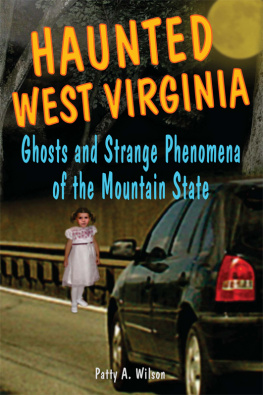


Published by The History Press
Charleston, SC
www.historypress.com
Copyright 2019 by Darla Spencer
All rights reserved
Front cover, top: Grave Creek Mound. Courtesy of Heather Cline; bottom left: Steatite platform pipe from Mound No. 21, the Great Smith Mound. Courtesy of Smithsonian Museum Department of Anthropology (Catalogue No. 90840); bottom center: Reconstructed turtle effigy tablet from Cresap Mound. Courtesy of the Carnegie Museum of Natural History; bottom right: Stone effigy bird head from Ancient City of Kanawha. Courtesy of the Smithsonian Museum Department of Anthropology (Catalogue No. 90710).
E-Book year 2019
First published 2019
ISBN 978.1.43966.729.3
Library of Congress Control Number: 2019935366
print edition ISBN 978.1.46713.865.9
Notice: The information in this book is true and complete to the best of our knowledge. It is offered without guarantee on the part of the author or The History Press. The author and The History Press disclaim all liability in connection with the use of this book.
All rights reserved. No part of this book may be reproduced or transmitted in any form whatsoever without prior written permission from the publisher except in the case of brief quotations embodied in critical articles and reviews.
This book is dedicated to my sons, Logan and Damon Hoffman.This project is presented with financial assistance from the West Virginia Humanities Council, a state affiliate of the National Endowment for the Humanities. Any views, findings, conclusions or recommendations do not necessarily represent those of the West Virginia Humanities Council or the National Endowment for the Humanities.
CONTENTS
FOREWORD
I have worked as an archaeologist in West Virginia for twenty-five years, specializing in Native American cultures before the arrival of Europeans. While most of my time has been spent working with other archaeologists, I have also interacted extensively with amateur archaeologists and the general public. An important takeaway for me from these diverse interactions is that many West Virginians, regardless of their background, education or profession, have an interest in knowing more about the ancient native peoples who once inhabited the hills, hollows and valleys of the state and, in particular, those who built and used the mounds and earthworks that were once a common element of the landscape in some of the states larger river valleys. To this end, it seemed obvious that having a volume that pulled together and clearly summarized the scattered information for these ancient mound-building societies, from which the states earliest landscape architects emerged, would benefit everyone from the professional archaeologist to the casual reader.
Having such summary works that would be useful to the professional and of interest and value to the public had long been the vison of my longtime friend and former co-worker Darla Spencer. As a native West Virginian, and having been educated in state and also having spent a good part of her career as a professional archaeologist, she was eminently aware of the difficulty many archaeologists and graduate students had in tracking down and acquiring reference materials for their research and, perhaps more importantly, how the general public held many misconceptions regarding the origin and history of the states native peoples. As the first step in fulfilling her vison, she utilized her considerable energy and talents to research the Late Prehistoric peoples of the state, which culminated in the publication of Early Native Americans in West Virginia: The Fort Ancient Culture. This well-received volume, published in 2016, provided an overview of the archaeology and lifeways for a specific period of time and cultural development in the states past and has become a valuable reference tool for the professional and non-professional alike.
Based on the overwhelming popularity of her 2016 publication, Spencer embarked to further her vision, and in her current work, Woodland Mounds in West Virginia, she has gathered information for many of the ancient mounds, and in particular those located in the Kanawha and Ohio River valleys, where the majority of previous research has been conducted. Using the same clear and informative writing style as in her previous volume, she provides a chronologically organized discussion of significant changes in Native American lifeways and culture, providing a context to better understand when and how some of the better-documented mounds in the state were constructed and used. Once the context is set, she describes, often in considerable detail, the excavations of the mounds and the artifacts that were recovered. The accompanying photographs provide a representation of the variety of artifacts placed within the mounds and clearly demonstrate the high level of skill and talent possessed by the ancient artisans of these mound-building societies.
While Im sure this volume will prove valuable to the professional, student and amateur archaeologist working in the Ohio Valley for the information and references it provides, I believe it will be more widely appreciated by the general public for the information and clarity it provides for the widely misunderstood topic of the Mound Builders.
MICHAEL ANSLINGER
PREFACE
Invariably, when someone discovers that I am an archaeologist, one of the first questions they ask is about the burial mounds located throughout the state. Sometimes they know of a mound on someones property that has not been recorded. The conical earthen mounds throughout West Virginia and the Ohio Valley are one of the only visible reminders that native people lived here long before the arrival of the first Europeans. That is one of my reasons for writing this book.
When the first Europeans crossed the Appalachian Mountains and arrived in the Ohio Valley, they were intrigued by the many conical earthen mounds they encountered there. For many years, these structures and their history were a mystery. They were thought to be the remnants of a lost race of people and not the ancestors of the Native Americans who were living in the Ohio Valley at the time. It was not until the 1880s, when the Smithsonian Institution sent investigators to explore the mounds, that this mystery was finally solved, and the ancestors of Native Americans were determined to be the builders of the mounds. This was also the beginning of archaeology in America.
Over four hundred burial mounds have been recorded in West Virginia, but few have been professionally investigated. This volume will present an introduction to what is currently known about the early Native American mound-building cultures of the Woodland period in West Virginia and explore sixteen of the most well-known and better-documented mounds and groups of mounds throughout the state from this time. It is intended to be a reference for archaeologists as well as an introduction to the Woodland period for non-archaeologists.














